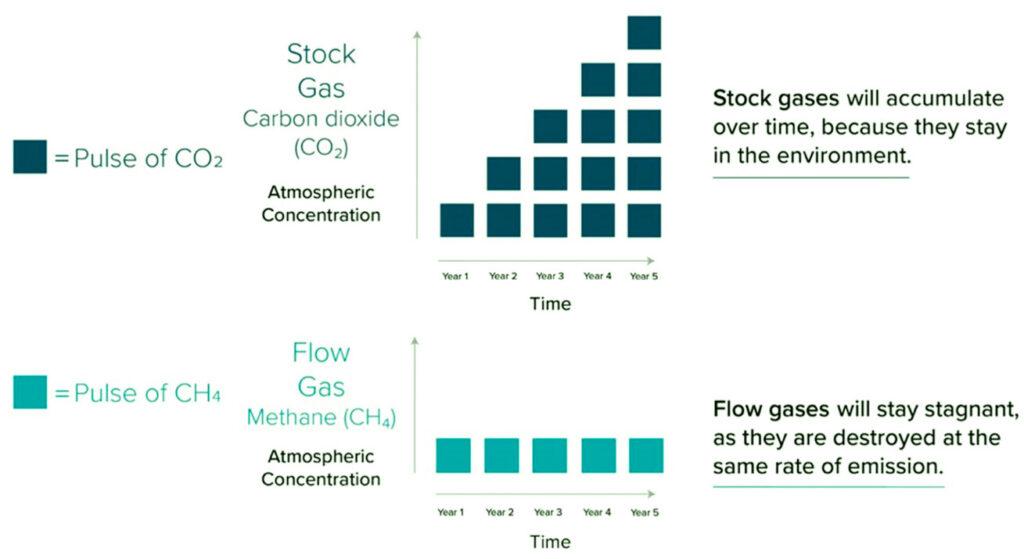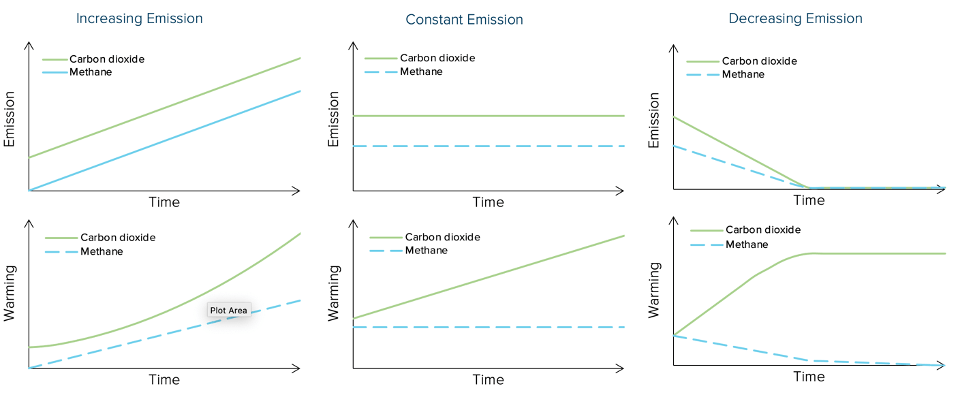
GWP100 is the standard agreed on the United Nations level, and it is widely used by countries for their emissions accounting. For gases that persist for over 100 years, like carbon dioxide (CO2) and nitrous oxide (N2O), GWP100 works well.
However, it has limitations in how it accounts for the impacts of short-lived climate pollutants (SLCPs) – or short-lived greenhouse gases, such as methane. Those limitations have been brought to light in 2023 by eight internationally recognised scientists, from eight respected UK research institutions, who authored a detailed academic letter in support of using GWP* as an additional metric in assessing climate impacts.
The main difference between GWP100 and GWP* is that the former is deemed to be a static metric, and the latter a dynamic one. GWP100 expresses the heat-trapping ability of a specific gas relative to carbon dioxide over 100 years. GWP* accounts for short-lived gases (e.g., methane) being actively removed from the atmosphere within approximately 12 years after being emitted.
But what does that really mean? Read on.
Greenhouse gas emissions have traditionally been converted to CO2-equivalents (CO2e) by multiplying the gas by GWP100 (global warming potential) over a 100-year time horizon. Agrecalc uses coefficients published in the Fifth IPCC Report, also known as AR5.
The full AR5 table can be found here: Global Warming Potential Values.
The most recent internationally accepted table of coefficients can be found in the Sixth IPCC Report, also known as AR6. The Summary for Policymakers (SPM) document was drafted by scientists and agreed to line-by-line by the 195 governments (including the UK) in the IPCC during the five days leading up to 6 August 2021.
However, the UK’s National GHG accounting currently uses the factors from AR5.
The table below illustrates the figures from both Reports*:
Gas | GWP100 factor AR5 | GWP100 factor AR6 | Lifespan |
Carbon Dioxide (CO2) | 1 | 1 | Thousands of years |
Nitrous Oxide (N2O) | 265 | 273 | About 110 years |
Methane (CH4) | 28 | Fossil: 29.6 Non-fossil: 27.0 (relevant for agriculture) | About 12 years |
*Table source and copyright: AHDB
GWP100 expresses the heat-trapping ability of a specific gas relative to carbon dioxide over 100 years. Therefore – deemed to be a static type of metric.
Thus, CO2 has the global warming potential of 1, and methane of 28 (AR5) or 27 (relevant for agriculture in AR6). This means 1 ton of methane is equal to 28/27 tons of CO2 and therefore captures more heat per molecule.
GWP100 overstates the effect of constant methane emissions on global surface temperature by a factor of 3-4 but understates the effect of any new methane emissions by a factor of 4-5 over the following 20 years. This is because methane in the atmosphere behaves like a ‘boy racer’ – it constantly ‘revs up the throttle’ by trapping the heat and raising the temperature in ‘short bursts’ (only present for 12 years), before being broken up by atmospheric processes and losing its potency to warm it up.
And methane is a potent greenhouse gas. As such, it plays a crucial role in the Earth’s climate system – it traps heat far more effectively than carbon dioxide over shorter time periods. It is naturally present in the ground (e.g., peatlands / wetlands), under the seabed, or in volcanoes.
It is also present in the rumen of agricultural animals, such as bovines and ovines / caprines (sheep and goats), collectively known as ruminants.
This is exactly what is being argued in the scientific letter above. The Oxford research stating that methane should be treated as ‘a temporary pulse, rather than a constant agent of warming’, is the basis of a new metric – GWP* – being presented as an alternative to GWP100.
The proponents of the new metric offer it as a new path and hope to livestock becoming climate neutral, and therefore part of the solution agriculture can offer in combatting climate change. Their point can be roughly illustrated below:

Dr Rachael Ramsey, Agrecalc Head of Science and Research, says: “GWP* is an alternative way of reporting GHG emissions that is gaining increasing attention in climate science and policy, as it considers the impact of shorter-lived greenhouse gases, such as methane, on global warming.
“Traditionally GWP100 is used to measure the impact of different greenhouse gas emissions on global warming, and assumes that all GHGs have a similar warming impact over a 100-year period relative to carbon dioxide.
“However, methane breaks down much faster in the atmosphere and has a much stronger upfront warming or “pulse” impact relative to CO2.”
GWP* has not yet been formally adopted by international climate scientists, but it was suggested by the Intergovernmental Panel (IPCC) in 2021 that policymakers should use the GHG metric they think is best. The IPCC states, ‘The choice of metric and time horizon can affect the distribution of costs and the timing of abatement between countries’. Further discussions on the science and policy implications will continue at COP28 but movement on these complex issues can be slow.
Although GWP100 is the most well-known and scientifically accepted (by the IPCC) method of GHG potential calculation, this method has faced criticism for its narrow focus on long-term effects and its inability to account for the complexities of methane’s behaviour in the atmosphere.
The flaw in GWP100 measurements was assessed a few years ago by researchers based at the University of Oxford. GWP100 assumed that all greenhouse gases remained in the atmosphere for centuries. What GWP100 did not account for was that methane, as a short-lived gas, was actively removed from the atmosphere within approximately 12 years after being emitted. Therefore, the GWP* is deemed to be a dynamic metric.
Alice Rocha, M.S. from University of California in Davis, employs this analogy in her blog:
“Imagine you have two bathtubs. Both have faucets that are on, and water is flowing. However, only one of these bathtubs has a drain. The tub with the drain represents methane and the one without represents CO2. Because the drain is removing water, the tub will not fill up and overflow. That is what happens with methane in the atmosphere. Its short-lived nature means that the gas is actively being removed from the atmosphere and thereby reduces its contribution to warming over long periods of time.”

Dr Ramsey, however, cautions about being too optimistic by what is being promised as a ‘silver bullet’: “The GWP* calculation, unlike GWP100, aims to take both these factors into account but there is still significant debate with the climate science community on whether GWP* sufficiently improves upon existing metrics like GWP100 to justify its adoption as the standard for measuring climate impact.
For example, GWP* is not currently accepted as a reporting metric by the IPCC, but it is under consideration for possible inclusion in the IPCC guidance as a reporting metric in the future.”
"There is still significant debate with the climate science community on whether GWP* sufficiently improves upon existing metrics like GWP100 to justify its adoption as the standard for measuring climate impact. For example, GWP* is not currently accepted as a reporting metric by the IPCC, but it is under consideration for possible inclusion in the IPCC guidance as a reporting metric in the future.”
Dr Rachael Ramsey, Agrecalc Head of Science and Research
Agrecalc has been working closely with the scientific teams who have been developing and refining the GWP* metric and have decided to enable GWP* as an elective, additional reporting metric in our tool.
AHDB states on their website that “pragmatically, the industry should report emissions using both GWP* and GWP100 as echoed in UK industry Road Maps and by Beef and Lamb NZ”.
Their argument is that there exists “the importance of using multiple metrics for calculating the climate impact of foods, as using just one metric doesn’t give the whole picture”.
NFU on their website advise that “GWP* should not divert attention from taking action; instead, policy could actively incentivise actions if the temperature impact of methane reductions was valued.
“As GWP* uses 20 years of aggregate data the results from individual farms can be very different compared to the national herd or flock. For example, buying a neighbouring farm would have an impact on your footprint under GWP* although it makes no difference to the national inventory.”
NFU also support dual reporting: “As outlined in the Dairy Roadmap, GWP* is useful for reporting aggregate emissions across sectors and to map global trends and targets. GWP100 is better used for benchmarking at farm level, as 20 years of data are needed for GWP* and not always available.”
In Agrecalc Cloud, this is possible by toggling a button to include GWP* calculations. When measuring GWP* using Agrecalc you may see that increasing methane emissions have a larger impact, but steady or declining methane emissions may have a much smaller impact and can even be negative.
Dr Ramsey concludes: “Our new GWP* toggle function will help both Agrecalc and researchers to determine the merits of GWP* as a reporting metric, and we would be grateful if the farming community offers us this opportunity with real-life farm data.”
While GWP* offers a more nuanced approach to accounting for the climate impacts of different pollutants, its complexity, uncertainties, and potential policy implications have led to significant debate within the climate science community.
Zach Boren, from Greenpeace’s Unearthed blog, argues that “though the science underpinning the metric is not controversial, its application is”. He quotes John Lynch, another Oxford academic in the GWP* team, saying that “The GWP* conversation needs to be had, […] however complex and contentious it could be”. Lynch adds: “What I really think we need is an open debate about these factors and the type of climatically sustainable future we want”.
We urge our readers and users to take into account that the metric is not yet adopted by the IPCC and other relevant organisations, and that it is by no means a silver bullet for their challenges. There is a long road, and more research needed before we can say with absolute certainty that the metric can and should completely replace the GWP100.
"We urge our readers and users to take into account that the metric is not yet adopted by the IPCC and other relevant organisations, and that it is by no means a silver bullet for their challenges. There is a long road, and more research needed before we can say with absolute certainty that the metric can and should completely replace the GWP100."
Dr Rachael Ramsey, Agrecalc's Head of Science and Research
The journey to a more sustainable agriculture industry relies on innovation and continuous improvement. With better science guiding our way, it’s crucial to embrace tools and technologies that are rooted in robust scientific foundations.
Table* summarising the benefits and downsides of both metrics:
GWP100 | GWP* |
Covers all GHGs | Currently only for methane (but could expand to other short-lived GHGs) |
Average warming potential over 100 years | Warming effect over time, but accounting for breakdown of methane (12 years) |
Focuses on fixed quantities of emissions | Focuses on change in rate of emissions over time |
Can use emissions data over any timespan | Currently requires emissions data over 20 years |
Less accurate representation of methane’s impact | More accurate representation of methane’s impact |
Formally adopted in international climate policy | Growing recognition, and IPCC have acknowledged its existence – but so far, no official national of international level adoption |
*Table source and copyright: AHDB.

Former journalist, now SEO writer and Head of Marketing, combining two great loves of content creation and tech. In charge of turning Agrecalc marketing vision into strategy and tangible assets.


After two years of operation as a Limited Company, Agrecalc became part of Scotland’s Rural College (SRUC) as of 1 April 2025.

Biochar is a carbon-rich material produced by pyrolysing biomass, which offers a variety of potential agronomic benefits. In this guest article, Black Bull Biochar discusses how these effects work together to bolster productivity, sustainability, and resilience in farming.